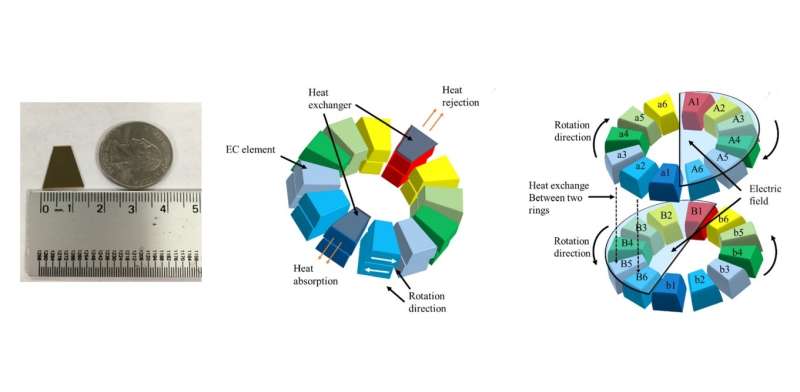June 26, 2017 feature
Electrocaloric refrigerator offers alternative way to cool everything from food to computers

(Phys.org)—Researchers have built an electrocaloric refrigerator the size of a beverage coaster that can generate a temperature difference of about 2 K between the hot and cold ends of the device. The cooling mechanism, which is based on the electrocaloric effect, involves alternately applying and removing an electric field to a material to increase and decrease the material's temperature, respectively. The new cooling method can potentially achieve a higher efficiency than current methods, indicating that electrocaloric cooling devices may one day replace today's refrigerators and other cooling devices.
"Compared with traditional cooling methods, the new cooling method described here has higher cooling efficiency and cooling power with a more compact size," coauthor Qiming Zhang, Distinguished Professor of Electrical Engineering and Materials Science at Pennsylvania State University, told Phys.org.
"With the continued development of electrocaloric materials, electrocaloric cooling devices have the potential to replace traditional vapor-compression-cycle-based cooling, which is widely used in air conditioners and refrigerators. Specifically, it can be used in wine chillers, computer cooling, localized climate control (distributed air conditioners), medical applications, and electric vehicles."
Zhang and his coauthors have published a paper on the electrocaloric refrigerator in a recent issue of Applied Physics Letters.
Although there have been other electrocaloric cooling devices, these devices typically use active regenerators as the heat transfer materials, and active regenerators experience heat loss due to the cyclic temperature changes they must endure. The electrocaloric device demonstrated here does not use active regenerators, which offers the potential of achieving a higher cooling efficiency and cooling power.
The new device contains multiple ceramic rings, each consisting of about a dozen coin-sized elements. Adjacent rings rotate in opposite directions at a rate of several revolutions per minute. When the elements of a ring rotate toward the hot end, an electric field is applied to the elements, causing them to eject heat. Conversely, when the elements rotate toward the cold end, the electric field is reduced to zero, causing the elements to absorb heat. Heat is exchanged between adjacent rings rotating in opposite directions, which further cools the cold end and heats the hot end of the device.
In previous work, some of the researchers of the current study showed in simulations how the device works, and the new study marks the first time that they have experimentally demonstrated the concept. Their prototype exhibits a temperature difference of 2 K between the hot and cold ends, corresponding to a regeneration factor that is on par with that of the best similar cooling devices. Since the prototype uses commercial ceramic materials and only two electrocaloric rings, the researchers expect that the device's performance can be significantly improved with better materials and additional rings. Developing ceramic materials with large electrocaloric effects is an area of active of research, and the researchers anticipate that some of these materials may be ideally suited for this type of cooling device.
"In the future, we will focus on developing electrocaloric materials (including polymer and ceramic) which can generate the electrocaloric effect at very low voltage," Zhang said. "We will also work on scaling up the current state-of-the-art electrocaloric materials to the commercial scale, which can be used reliably with an applied voltage of less than 200 volts."
More information: Tian Zhang et al. "An electrocaloric refrigerator with direct solid to solid regeneration." Applied Physics Letters. DOI: 10.1063/1.4986508
Journal information: Applied Physics Letters
© 2017 Phys.org




















